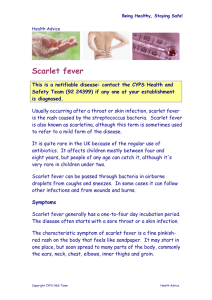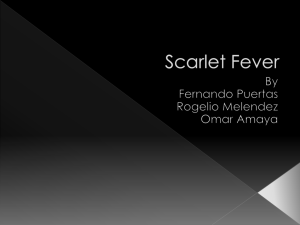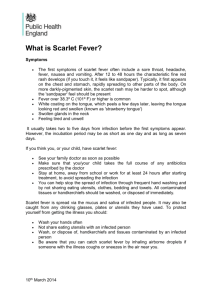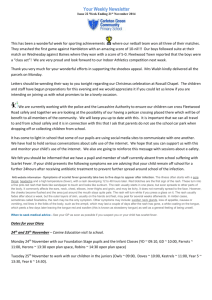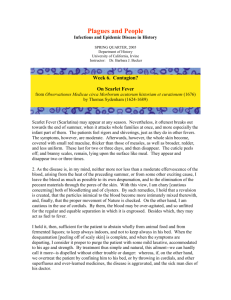bacterial infections of oral cavity
advertisement
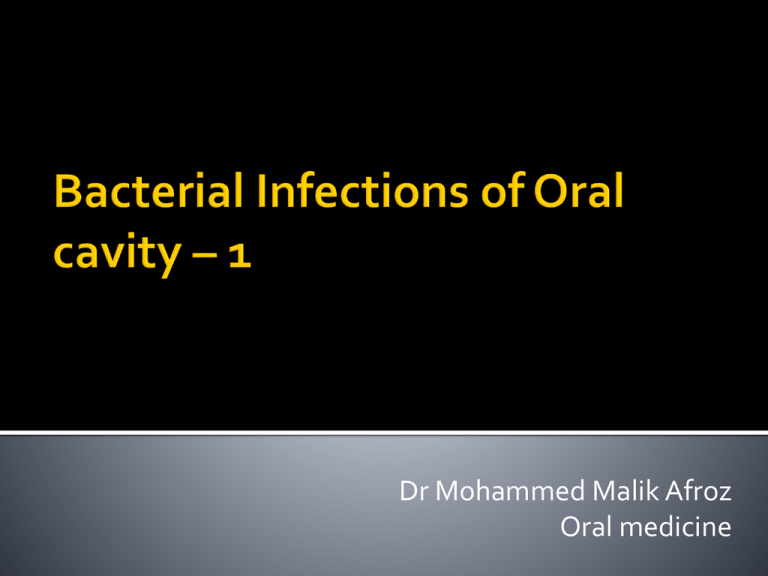
Dr Mohammed Malik Afroz Oral medicine BACTERIAL INFECTIONS – 1 1. 2. 3. 4. 5. Scarlet Fever Diptheria Tuberculosis Tetanus Actinomycosis BACTERIAL INFECTIONS – 2 1. 2. 3. 4. ANUG/Noma Cat scratch disease Syphilis Gonorrhea It is a highly contagious systemic infection occurring mostly in children It is caused by beta- hemolytic streptococci, st. pyogenes which produces a pyrogenic exotoxin There is presence of rash due to 3 exotoxins A, B , C previously described as erythrogenic or scarlet fever toxins. Incubation period of 3 to 5days followed by severe pharyngitis and tonsillitis , headache , chills . Fever and vomiting There is enlargement and tenderness of regional lymph nodes -characteristic feature – Is a appearance of diffuse, bright, scarlet skin rash in the regions of skin folds on the2nd or 3 rd day of illness Scarlet rash is due to the toxic injury to vascular endothelium which produces dilatation of small blood vessels and consequent hyperemia Small papules of normal color erupt through these rashes giving a sand paper feel to the skin The rash that is prominent in the areas of skin folds is called pasta lines The rash subsides after 6 or 7 days followed by desquamation of palms and soles •The palate and the throat is often fiery red •The tonsils and faucal pillars are swollen and sometimes covered with a grayish exudates. •The early stage of the disease on the tongue is described as “strawberry tongue” o\r “white strawberry tongue” In the later stage the tongue becomes deep red , glistening and smooth except for the swollen , hyperemic papilla and is termed as “raspberry tongue “ or “red strawberry tongue ‘ Diagnosis – culturing the flora of intra oral lesions in pharynx Dick Test – administering two different injections, one into each arm of a patient. In one arm, toxin (poison) taken from a culture of scarlet fever bacteria is injected. In the other arm, neutralized toxin is injected to act as a control (a standard of comparison). If the toxin causes redness, tenderness and swelling after 24 hours, the person is not immune to scarlet fever. The control normally shows no swelling for comparison. Treatment – Antibiotics like penicillin , dicloxacillin and cephalexin will eliminate the disease and controls complications Is an acute , infectious and communicable diseases of the skin and the mucous membrane caused by toxemic strains of corny bacterium Diptheriae Pathogenesis – has air borne mode of transmission and localizes in mucous membrane of respiratory tract. It invades open skin lesions due to insect bites or trauma. Bacillus multiplies at the entry site and liberates toxins. Toxins induce initial edema, hyperemia epithelial necrosis acute inflammation. Coagulation of the fibrin and purulent exudate produce a pseudo membrane & inflammatory reaction accompanied by vascular congestion extends into underlying tissues Mostly seen in children and mainly affects the upper respiratory tract The characteristic feature is a formation of a pseudo- membrane which is seen on the tonsils Has a wash leather , elevated greyish green membrane with a well defined edge surrounded by acute inflammation It manifests as a fever, sore throat , weakness, dysphagia , head ache And change of voice Formation of a passive, diphtheritic membrane which begins on the tonsils This membrane contains dead cells ,leukocytes, bacteria overlying necrotic, ulcerated area of the mucosa The pseudo membrane leaves a bleeding surface if stripped away Enlargement of sub mandibular and anterior cervical nodes will give a bull neck appearance Prevented by prophylactic active immunization with diphtheria toxoid once the diseases develops it is treated with anti- toxin usually in combination with antibiotics It is a specific granulomatous disease caused by mycobacterium tuberculosis Commonly affects lungs and also affects the intestines, meninges , bones , joints , lymph glands , skin and oral mucosa 2types – Primary TB Secondary TB Mild symptoms – fever, chills, cough, sputum Infected foci granulation scarring calcification Bacilli may get disseminated and involve various organs Main complication is loss of lung elasticity and decrease in function. Re – activation of infection Is more aggressive in nature. Multiple organ involvement is seen. Oral tuberculosis is due to pulmonary lesion and is contagious Gingiva and tongue are commonly involved. Common site – Base of tongue – gingiva – lip – tonsil – tooth socket – soft palate. Ulcers – uneven, jagged, undermined soft borders Lesions are painless but purulent Lymphadenopathy Unilateral lymph node involvement – scrofula Biopsy and culture is must. 0.1cc – 5 TU of PPD Montoux Test Sputum examination – Zeihl Neelson Stain Tissue biopsy. Induration or redness 48 – 72hrs +ve -> 10mm Inconclusive –5 –9mm - Ve -< 5mm False – ve –cross reactivity to other mycobacteriaor granulomatousdisease Chest Radiograph – apical scars with calcifications DOSAGES OF FIRST LINE ANTI TUBERCULOSIS DRUGS AND MAJOR ADVERSE EFFECTS Drug Daily weekly Adverse Effects Isoniazid 5 mg/kg oral (maximum 300 mg) 900 mg twice weekly 600 mg thrice weekly Hepatitis, peripheral neuritis, drug induced lupus, seizures, and hypersensitivity with rash and fever. Drug interactions with dilantin and disulfiram Rifampic 10 mg/kg in oral (maximum 600 mg) 900 mg twice weekly 600 mg thrice weekly Orange body secretions, flulike syndrome, hepatitis, thrombocytopenia, nausea, anorexia, diarrhoea, renal failure, and multiple drug interactions Dosage Drug Daily weekly Adverse Effects Pyrazina mide 25-30 mg/kg oral 30-35 mg/kg Hyperuricemia, hepatitis, rash, nausea, and anorexia Ethambut 25 mg/kg initial 50 mg/kg twice weekly Optic neuritis and gastrointestinal ol 2 months, then 30 mg/kg thrice discomfort 15 mg/kg oral weekly Streptom ycin 15 mg/kg IV or 15 mg/kg (maximum IM (maximum 1.5 g) twice or thrice 1.0 g) 5 days a weekly week Ototoxicity, vestibular dysfunction, nephrotoxicity, rash, and hypersensitivity reactions Is an acute infection of nervous system. It is caused by clostridium tetani . Incubation period – 2 to 14 days Pathogenesis – Under suitable anaerobic conditions the bacteria germinate and produces toxins (TETANOSPASMIN) It binds to peripheral motor nerve terminal nerve cell body presynaptic terminal blocks release of GABA – gamma amino butyric acid) Characterized by lock jaw or trismus due to spasm of masseter which is an initial symptom . Dysphagia , stiffness or pain in the neck , shoulder or back muscles appear . Laryngeal spasm may lead to asphyxia . Sustained contraction of facial muscles results in risus sardonicus . The contraction of muscles of the back produces an arched back called opisthotonus Cephalic tetanus characterized by trismus and facial palsy is rare and may occur after head injury or ear infection . General measures : aims to remove spores at the site of wound , prevent toxin production , prevent muscular spasms . Cardiopulmonary monitoring should be maintained . Antibiotics should be given to eradicate vegetative organisms . Penicillin 10- 12 million units iv for 10 days , metronidazole 1gm every 12 hrs should be administered. Antitoxin is injected to neutralize circulating toxin and unbound toxin within the wound . Prophylaxis- wound debridement and booster doses of tetanus toxoid . A chronic granulomatous suppurative and fibrosing disease caused by gram positive non acid fast branched filamentous organism namely actinomyses israelli , A.viscosus and A. propionica Types – according to anatomical to location (1) cervico- facial (2) abdominal (3)pulmonary forms SWELLING DEVELOPS IN THE FACE AND THE NECK WITH INDURATION of tissues Swelling develops into 1 or more abscess produces pus having a characteristic sulphur granules . The skin overlying the abscess is purpulish red , indurated and has the feel of wood or often fluctuant Infectious spread to mandible or maxilla may result in actinomycotic osteomyelitis long standing fibrosing cases are treated by draining the abscess excising the sinus tract under a high dose of antibiotics( penicillin and tetracycline ) Organism Disease Toxin Further Information Clostridium tetani Tetanus Tetanospasmin Blocks action of inhibitory neurones Corynebacterium diphtheriae Diphtheria Diphtheria toxin Inhibits elongation factor- 2 (EF2) by ADP ribosylation DTaP – given for DIPHTHERIA that is often combined with TETANUS TOXOID and ACELLULAR PERTUSSIS as a series of injections during infancy and childhood. Toxoid is prepared by mixing formaldehyde with the poisonous toxin produced by Corynebacterium diphtheriae, rendering the toxin harmless.
